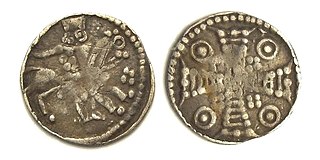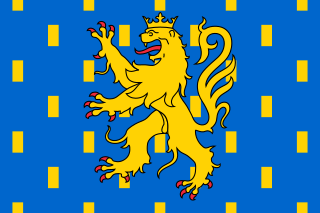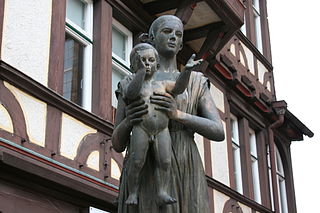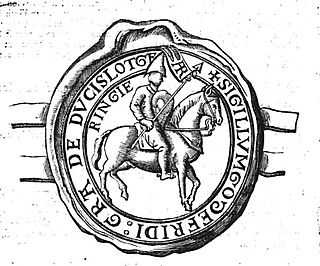
The House of Zähringen was a dynasty of Swabian nobility. The family's name derived from Zähringen Castle near Freiburg im Breisgau. The Zähringer in the 12th century used the title of Duke of Zähringen, in compensation for having conceded the title of Duke of Swabia to the Staufer in 1098. The Zähringer were granted the special title of Rector of Burgundy in 1127, and they continued to use both titles until the extinction of the ducal line in 1218.

Henry I, named "The Courageous", was a member of the House of Reginar and first duke of Brabant from 1183/84 until his death.

The Free County of Burgundy or Franche-Comté was a medieval county of the Holy Roman Empire, predecessor to the modern region of Franche-Comté. The name franc(he) comté derives from the title of its count, franc comte, in German Freigraf 'free count', denoting imperial immediacy. It should not be confused with the more westerly Duchy of Burgundy, a fiefdom of France since 843.

Henry I of Hesse "the Child" was the first Landgrave of Hesse. He was the son of Henry II, Duke of Brabant and Sophie of Thuringia.
The counts of Nevers were the rulers of the County of Nevers, which became a French duchy in 1539, with the rulers of the duchy calling themselves dukes.

The Duchy of Cleves was a State of the Holy Roman Empire which emerged from the medieval Hettergau. It was situated in the northern Rhineland on both sides of the Lower Rhine, around its capital Cleves and the towns of Wesel, Kalkar, Xanten, Emmerich, Rees and Duisburg bordering the lands of the Prince-Bishopric of Münster in the east and the Duchy of Brabant in the west. Its history is closely related to that of its southern neighbours: the Duchies of Jülich and Berg, as well as Guelders and the Westphalian county of Mark. The Duchy was archaically known as Cleveland in English.

Godfrey I, called the Bearded, the Courageous, or the Great, was the Landgrave of Brabant, Count of Brussels and Leuven (Louvain) from 1095 to his death and Duke of Lower Lorraine from 1106 to 1129. He was also Margrave of Antwerp from 1106 to his death.

Count Palatine Wolfgang of Zweibrücken was member of the Wittelsbach family of the Counts Palatine and Duke of Zweibrücken from 1532. With the support of his regent, his uncle Rupert, Wolfgang introduced the Reformation to Zweibrücken as early as 1537.

Adalbert was the king of Italy from 950 until 961, ruling jointly with his father, Berengar II. After their deposition, Adalbert continued to claim the Italian kingdom until his defeat in battle by the forces of Otto I in 965. Since he was the second Adalbert in his family, the Anscarids, he is sometimes numbered Adalbert II. His name is occasionally, especially in older works, shortened to Albert.

The Anscarids or the House of Ivrea were a medieval Frankish dynasty of Burgundian origin which rose to prominence in Italy in the tenth century, even briefly holding the Italian throne. The main branch ruled the County of Burgundy from the eleventh to fourteenth centuries and it was one of their members who first declared himself a count palatine. The cadet Castilian branch of Ivrea ruled the Kingdom of Galicia from 1111 and the Kingdoms of Castile and León from 1126 until 1369. The House of Trastámara, which ruled in Castile, Aragon, Naples, and Navarre at various points between the late 14th and early 16th centuries, was an illegitimate cadet branch of that family.
Otto, Count of Ballenstedt, called Otto the Rich, was the first Ascanian prince to call himself count of Anhalt, and was also briefly named duke of Saxony. He was the father of Albert the Bear, who later conquered Brandenburg from the Slavs and called himself its first margrave.
The Bosonids were a dynasty of Carolingian era dukes, counts, bishops and knights descended from Boso the Elder. Eventually they married into the Carolingian dynasty and produced kings and an emperor of the Frankish Empire.

Otto I, a member of the House of Andechs, was Duke of Merania from 1204 until his death. He was also Count of Burgundy from 1208 to 1231, by his marriage to Countess Beatrice II, and Margrave of Istria and Carniola from 1228 until his death.

The House of Andechs was a feudal line of German princes in the 12th and 13th centuries. The counts of Dießen-Andechs obtained territories in northern Dalmatia on the Adriatic seacoast, where they became Margraves of Istria and ultimately dukes of a short-lived imperial state named Merania from 1180 to 1248. They were also self-styled lords of Carniola.

Sibylle of Brandenburg was a Princess of Brandenburg by birth and by marriage Duchess of Jülich and Duchess of Berg. She was the governor-regent of Jülich-Berg for her daughter Maria from 1511 to 1524.